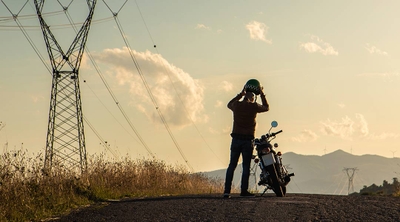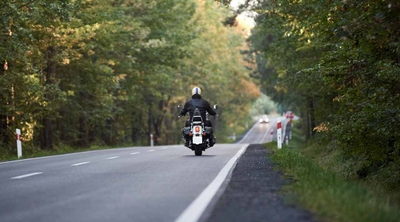A guide to protective motorcycle gear
3 min read
What is your philosophy when suiting up for a ride? Do you wear the same gear for a quick ride to breakfast as you do for an all-day or weekend trip? Regardless of your confidence or competence in your motorcycle riding skills, other drivers and changing road and weather conditions like riding a motorcycle in the rain, pose the biggest threat to a motorcycle rider.
Drivers are increasingly distracted by devices, leading to decreased attentiveness and reaction time behind the wheel. You must protect yourself and reduce the possibility and severity of an injury or an accident by wearing protective motorcycle gear.
What protective motorcycle gear do I need?
Here’s a quick motorcycle safety gear list of the best and most essential safety gear for motorcycle riders. Remember that riding gear protects your body in case of an accident and from natural elements such as wind, debris, and weather.
Motorcycle helmet
The number one item on your motorcycle safety gear list should be a helmet. We all know the facts and the importance of protecting your head (and brain) when riding a motorcycle. Head injuries and severe brain trauma require the longest recovery time. Some people never recover from traumatic brain injuries from traffic crashes. It still shocks me when I see riders without helmets when I travel to states without helmet laws.
There are plenty of helmet options, each with varying levels of protection. Also, your helmet should provide eye protection. A model with a full or partial face shield is recommended. If you choose an open-face or half-size helmet, you’ll need to consider goggles or other protective eyewear. Learn more about how to choose a motorcycle helmet.
Riding jacket
Most motorcycle jackets are made of leather, Kevlar, Cordura, or other synthetic textiles. These materials protect your skin from nasty road rash. For protection against impact, a good jacket should include additional protection and padding for your back, elbows, and shoulders. Advances in technology have also resulted in some airbag-enabled jackets and vests.
For a versatile jacket, look for a removable liner and adjustable venting that can make it useful in hot and cold weather. No matter your fashion and style preference, you can find motorcycle safety clothing that suits — and protects you — while riding.
Gloves
Like riding jackets and other motorcycle safety clothing, motorcycle gloves are available in leather, Kevlar, Cordura, or a combination of natural and synthetic materials. Many include protective padding for your knuckles and palms. Some gloves with larger gauntlets can also provide additional padding and protection for your wrists.
Gloves not only protect your hands in an accident, but many also provide functional riding enhancements. For example, some gloves include textured surfaces on the fingers for a better grip on the clutch and brake levers. Plus, some include wiper/squeegee material to help you clear your face shield of rain or other debris.
Boots
Often overlooked, motorcycle boots are critical for a safe and comfortable riding experience. First, they should be weatherproof and lightweight. Second, they should provide enough stiffness to protect and flexibility for comfort off the bike. Good motorcycle boots should also have additional padding on the left boot, so you don’t strain your foot when shifting the motorcycle’s gears.
However, the sole is the most important part of a motorcycle boot. Because road surfaces vary and change depending on weather conditions, boots must provide sufficient grip and be resistant to oil and other fluids on the road. Also, because motorcycles can be heavy, a good boot should provide sufficient ankle support so as not to fatigue the foot when stopping at traffic lights.
Earplugs
An essential item of safety gear for motorcycle riders are earplugs. Even if you’re not riding a cruiser with a throaty V-twin engine, motorcycles can be noisy. Add wind and traffic noise to the mix, and it doesn’t take long for ear fatigue from excessive exposure to these high-decibel noises to set in.
To protect your hearing, I suggest using at least low-cost, industrial-use foam plugs. Choosing a higher-quality solution will give you a better fit and more attenuation. So, invest in your ears by getting custom-molded plugs. Our ears are like fingerprints — everyone is different. Several companies offer earplugs designed for motorcycle riding. And an audiologist can also make you a custom-fitted set in a week or two.
High-visibility vest
High-visibility and reflective motorcycle vests are the best riding gear for visibility and are low-cost. They help ensure that we are visible. As highway and road crews use them, many motorcyclists wear these vests to maximize visibility.
Some textile motorcycle riding jackets are available in high-visibility and reflective colors. However, if yours is not, a high-visibility vest is an excellent option, especially when riding in high-traffic and high-density population areas.
Ride safe and wear the safest motorcycle gear to protect you in any riding situation. It’s important to be comfortable but also to be smart. Advances in protective and preventive motorcycle safety products will help keep you safe. Learn more about how to ride a motorcycle.






